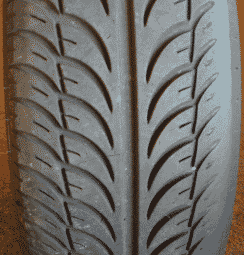 Camber Angle Basics Camber Angle Basics
Today this angle is properly the most common to be misdiagnosed as tracking wear. The principle of the angle is to distribute the cars weight evenly across the width of the tyre thus maximising grip, but this angle demands the most complicated amount of maths of all the angles.

As the pictures suggest, if the camber is considered negative then it will lean in toward the cars centre line relative to the vertical, and the opposite will be found for positive, the main problem with camber is it has an active range which is expressed by the suspension, example being if the front camber setting is 30 min negative in a relaxed condition then it will progress to 60 min when hitting a bump (loaded) and drop to zero min off the bump (unloaded) this is fine but all those bumps and pot holes over the years may have moved, bent or compressed the cars camber beyond the relaxed 30 min, now loaded or unloaded the angle is dynamically out of range.
Camber is the most violent angle of them all as far as tyre wear is concerned, and has the ability to wear down to the wire in as little as 1000 miles, although not realising the poor handling will need to be blatantly ignored
The way to recognize camber wear is by the damage, it is smooth and confined to a very small area normally about 10% of the total tyre width, often the remaining tread has little or no wear, the vast majority of camber problems lean toward the negative (see picture above) and violently wears the tyre in an unseen area deep inside the heel arch, so it would take a conscious effort to realize a problem, usually it will be the tyre centre that informs you, sometimes the police, and the possibility of the centre reservation has been realized by many an unsuspecting motorist.

Another common reason for camber wear is changing from standard tyres and wheels, to a larger diameter rim and a smaller profile tyre, the geometry is based on the dynamic range of the suspension, and the on/off camber tolerances are calculated for a known tyre width, the wider tyre will move the weight distribution nearer to the (on,) or (loaded) state, so it can be seen that the active camber will be out of tolerance, and is now considered normal.
The intention to change to bigger, wider wheels and tyres must be approached with caution, the wheels camber must be re-set nearer to the off or (unloaded) setting, accommodating for the extra tyre width.
About 20% of cars in the UK have camber adjusters fitted as standard, so it is possible to compensate easily for the wider tyre, and about another 50% are adjustable by using forced adjusters, developed in the USA and made available in the UK in response to this increasing pattern of wear, and a market that is realizing the standard new car set up is subject to change,
Consumer, and I won’t say (ignorance) lends to the fact that often when buying a new car you may be offered as an extra different sizes of wheel and tyre, but never would you expect the salesperson say “would you like a shorter wishbone with that”
When any wheel alignment or geometry is performed there is made available conversions for the bigger than standard wheel, since it is the reference point that the machinery will gauge upon, there are two reasons for this, first, standard or linear toe readings will be amplified if there is a bigger wheel fitted so the reading and setting would be false, second the bigger wider tyre will address a different area in the geometry range so known corrections are made available for the operator to compensate.
The worst fact about this is that the aftermarket recognizes that the geometry will need to be customised but the salesperson does not, or does not care, then you are left to resolve the wear issue, and hope that the tyre centre can recognise the wear pattern, is it wheel alignment?, or is it camber?
Summary
Camber wear is violent and confined to a small area of the tyre.
Non standard wheels can be a reason for camber wear problems.
if camber is knocked out it will disturb the wheel alignment but the wear pattern and method of correction are miles apart (be wise) camber can cause a pull even from the rear of the car, wheel alignment apart from it’s wear will not, (don’t be fooled)
|